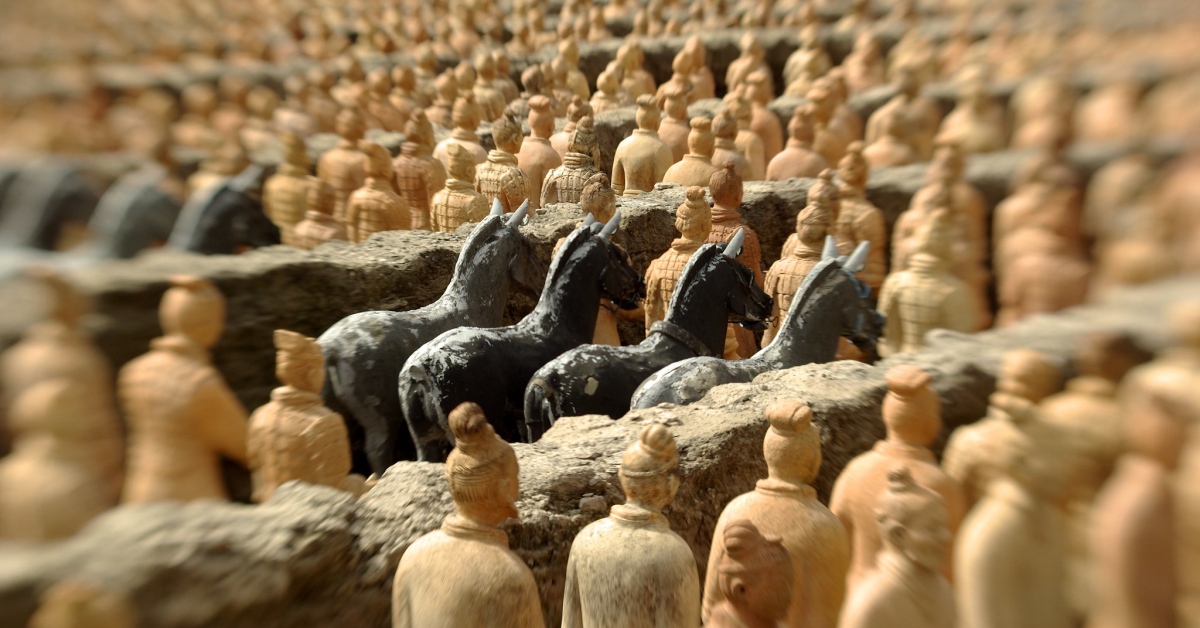All of those soldiers have a unique face. And who knows how many more may be hiding out there?

In March 1974, farmers digging a well in a field approximately 20 miles east of the Chinese city of Xi’an stumbled upon a pit containing 6,000 life-size terracotta statues. Archaeologists soon identified the site as the burial place of Emperor Qin, an effective and powerful ruler and a foundational figure in China’s history who lived between 259–210 BCE. He not only united the country, but also introduced imperial rule that lasted for more than 2 millennia.
Emperor Qin was also known for his cruelty. He showed little regard for the life of the conscripts who built his grandiose public works projects, including his burial complex. Historians believe that some 700,000 workers worked for nearly three decades on the mausoleum, many of whom died during its construction, while others were reportedly killed in order to keep the secrecy of the tomb’s location and the treasures buried within.

Excavations began almost immediately after the site was discovered. In addition to the initially uncovered pit containing 6,000 soldiers, a second pit was found with cavalry and infantry units and a third containing high-ranking officers and chariots. A fourth pit remained empty, suggesting that the burial pit was left unfinished at the time the emperor died.
So far, archaeologists have uncovered a 20-square-mile (52-square-kilometer) compound, including some 8,000 terracotta soldiers, along with numerous horses and chariots. They also found a pyramid mound marking the emperor’s tomb, remains of a palace, offices, stables and store houses. The army of life-size terracotta soldiers was stationed in military formation near the tomb in order to protect the emperor in the afterlife.

It’s hard to believe but out of those 8,000 soldiers in this huge otherworldly army, each has distinct facial features!
Many of the figures were apparently vandalized soon after the emperor’s death, and their restoration was a painstaking process. Nevertheless, it revealed that the soldiers were created using molds and an early assembly-line-type construction, which accounts for the fact that most of their hands are identical. And although only eight molds were used to shape their heads, distinctive surface features were added with clay after assembly. As a result, each terracotta soldier looks unique in its facial features, revealing a high level of craftsmanship and artistry.

Even though 40 years have passed since the discovery, less than 1 percent of the site has been excavated. Initially, archaeologists feared that the corpse and the artifacts within the tomb would be damaged, but then some even more practical concerns came up.
According to an account by the first century B.C. Chinese historian Sima Qian, entitled “The Grand Scribe’s Records,” streams of mercury – considered as an elixir of life at the time – were inlaid in the floor of Qin’s burial chamber to simulate local rivers running through his tomb.
Since the presence of mercury would mean serious safety hazards involved with excavation, in 2005 a team led by Chinese archaeologist Duan Chingbo tested 4,000 samples from the earthen burial mound for mercury, and they all came back highly positive. A laser scan of the compound in 2020 arrived at similar results.
With such historical and scientific evidence at hand, experts still debate whether to excavate the tomb at all, and if yes, what methods should be used to best protect what’s inside as well as the people working there.

So for now, we have to content ourselves with the breathtaking craftsmanship and artistry of what has already been discovered of the secrets of Emperor Qin’s tomb.
Sources: 1, 2, 3, 4
